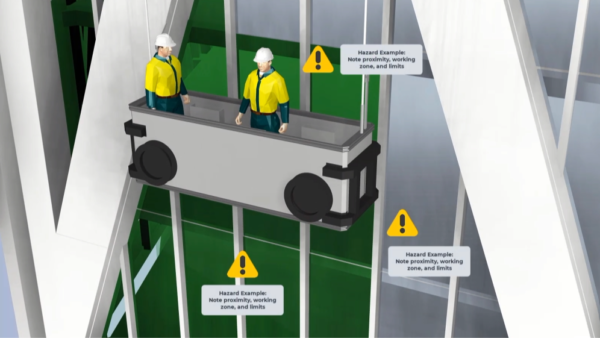
Feel like you’re lost in a tsunami of emails? Can’t find the crucial project details you need in your fit-to-burst inbox? It’s time to think about email management, says Marcus Roberts, head of Atvero.
Effective communication is the key to successful project management. However, the substantial volume of emails exchanged internally and externally among stakeholders can create significant challenges, as each instance of communication must be meticulously tracked and managed.
The complexity of email management is amplified in the construction environment as it is characterised by strict regulatory requirements, multiple collaborators, and frequent updates.
Misplacing an important document or missing an update can lead to a breakdown of communication between parties, expensive delays, and even legal issues. Thus, email management has become both a logistical and a strategic imperative for construction firms.
“Misplacing an important document or missing an update can lead to a breakdown of communication between parties, expensive delays, and even legal issues.”
From the overwhelming volume of communication to the need for precise coordination across diverse teams, firms face significant and unique challenges in staying on top of digital communication.
By understanding these challenges and implementing effective email management strategies, construction professionals can save time with enhanced project efficiency, improved collaboration, and ensured successful delivery of their projects.
The six key challenges are:
- Volume of communication.
- Information overload.
- Collaboration and coordination.
- Documentation and record keeping.
- Security and archives.
- Tools and solutions
Volume of communication
On construction projects, the number of stakeholders is extensive and grows with the size of the project itself. Each group requires a different level of update, approval and coordination at different points in the process. With email being the primary method of delivering information, this often leads to a high volume of email exchanges, as each step or change in the project brings with it a new wave of correspondence.
Projects lean towards being dynamic, with frequent changes in timelines, specifications and range. When these changes occur – whether through new regulatory requirements, client demand or even site conditions – they must be communicated to every party as quickly and clearly as possible.
These changes lead to differing email threads containing updates, instructions, feedback, and direction, all of which can be overwhelming or easily overlooked, leading to a high risk of miscommunication and oversight.
Throughout a project there will be a constant influx of emails which can make it challenging to organise and maintain if there is not an email management system in place.
Information overload
A key challenge of email management is the volume of information related to a single project that must be processed daily. Each email or email thread contains a range of different information, whether it’s a critical update, routine notification, or miscellaneous (but relevant) content.
Managing these emails – identifying which ones require immediate attention, which are important, and which can be left until later – is not only a daunting task, but a time-consuming one. Not having an appropriate system in place to prioritise important emails can lead to missing crucial communication, which can cause delayed responses to time-sensitive problems.
Another issue with the high volume of information is that the more emails you receive, the greater the risk of missing critical updates or instructions. When key emails become buried in a sea of other minor updates, they may not be seen promptly. Missing these important emails can lead to serious issues, such as non-compliance with regulatory requirements, safety incidents and project delays.
The volume of emails can lead to a sense of chaos and may cause team members to become overwhelmed, leading to a time-sink and reduced efficiency overall.
“Finding time to accurately store, file and categorise emails for each project daily can sometimes be an impossible and never-ending task.”
Collaboration and coordination
One of the key pillars of the industry is collaboration as projects involve multiple teams working together towards a common goal. Each team has their own responsibilities and deliverables, but all must work in harmony to ensure successful project completion.
Coordinating project information well can help to avoid conflicts and guarantee that everyone is aligned with the project’s objectives and on the same timelines. Delays or misalignment in communication can be detrimental as they can cause project delays, errors and a need for rework. Effective email management is essential in avoiding this as it assures the right information reaches the right person/people at the right time.
Within larger projects, there is also a greater chance of a team or team member working in a different geographical region to the project itself. This, combined with the rise in remote working, emphasises the need for clear communication and collaborative efforts. These location factors add a layer of complexity to collaboration as a whole and highlight that all team members must be on the same page, despite the differences in location.
Documentation and record-keeping
Maintaining detailed records is not just good practice, but a legal and regulatory requirement that is strictly upheld.
Communication detailing decisions and changes during a project’s lifecycle is critical, as in the event of a claim, dispute or litigation, there needs to be a complete and easy-to-access record of all actions taken and who is accountable for those actions.
Managing the high volume of emails for a project can be incredibly challenging for construction professionals, as well as a large time-sink. Finding time to accurately store, file and categorise emails for each project daily can sometimes be an impossible and never-ending task. Inconsistencies across the team with categorisation and filing of emails can lead to missed or lost information that might cause major issues later on.
Traditional email systems also may not have great search functionalities, which makes searching for an email as far as 10 years back sometimes impossible and incredibly time-consuming.
Security and archives
Projects pose a particular digital security risk, as sensitive information is regularly exchanged through email, including:
- designs;
- financial information;
- personal data of employees and clients; and
- contracts.
This information poses significant risk if leaked or mishandled and has the potential to cause a breach of trust with clients if an error occurs.
A great way to mitigate these risks is to ensure that you perform regular security audits and verify that your systems are up to date and compliant with security protocols. Another way to avoid mishandled information is to have an approval process in place that acts as a final check before any information is sent out.
Thorough archiving and reliable backup of information is also crucial for construction firms, as the long-term protection of project information is now a legal requirement. Emails can now be considered part of this and are essential to preserve communication relating to different projects. By having a system that allows them to be organised and fully searchable, the data becomes instantly accessible.
Tools and solutions
Currently, there are a number of tools available that can address construction-related issues when it comes to email management. When selecting an email management solution, there are a few factors that are crucial to look out for:
- A user-friendly interface should be intuitive for easy adoption and navigation, with customisation options and comprehensive support to boost productivity and user satisfaction.
- Assisted filing automatically organises emails by conversation and files future emails within the same thread, reducing manual effort and improving efficiency.
- Advanced searchability enables quick access to emails, attachments and documents with wide search capabilities, enhancing decision-making, collaboration and accuracy.
- Seamless control offers consistent email access across Windows, Mac and mobile devices, ensuring flexibility and productivity for all team members.
- Reliable security should include regular backups, protection from unauthorised access, and compliance with data protection standards to safeguard sensitive project information.
- Cloud-based storage provides scalable, cost-efficient storage with remote access capabilities, supporting the firm’s growth and facilitating flexibility and collaboration.
Don’t miss out on BIM and digital construction news: sign up to receive the BIMplus newsletter.











